Why you can trust Tom's Hardware
Comparison Products
We tested the 1TB WD Black SN750 SE against some of the best SSDs available. We added a few WD family members to the mix including the Blue SN570, Black SN750, and Black SN850, as well as the Kingston KC3000, Samsung 980, Samsung 970 EVO Plus, and Crucial P5 to see how it fares.
Trace Testing - 3DMark Storage Benchmark
Built for gamers, 3DMark’s Storage Benchmark focuses on real-world gaming performance. Each round in this benchmark stresses storage based on gaming activities including loading games, saving progress, installing game files, and recording gameplay video streams.

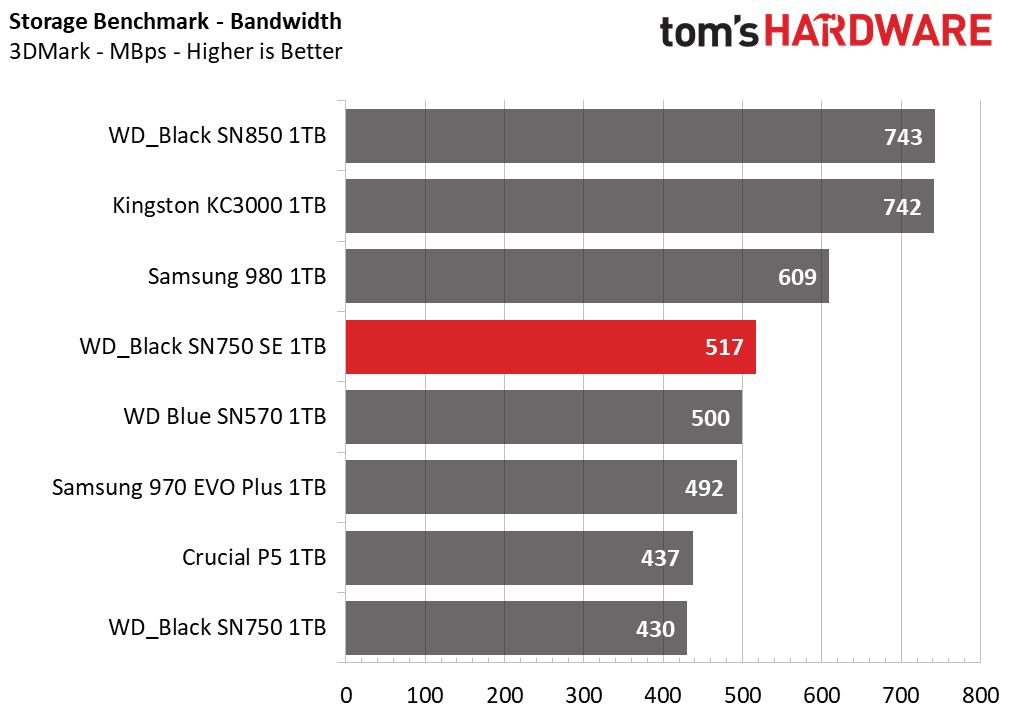

The WD Black SN750 SE lagged behind the high-end PCIe 4.0 competitors and was hardly faster than the Samsung 970 EVO Plus and WD Blue SN570. Samsung’s 980 even managed to jump ahead of the SN750 SE in this benchmark.
Trace Testing – PCMark 10 Storage Benchmark
PCMark 10 is a trace-based benchmark that uses a wide-ranging set of real-world traces from popular applications and everyday tasks to measure the performance of storage devices.


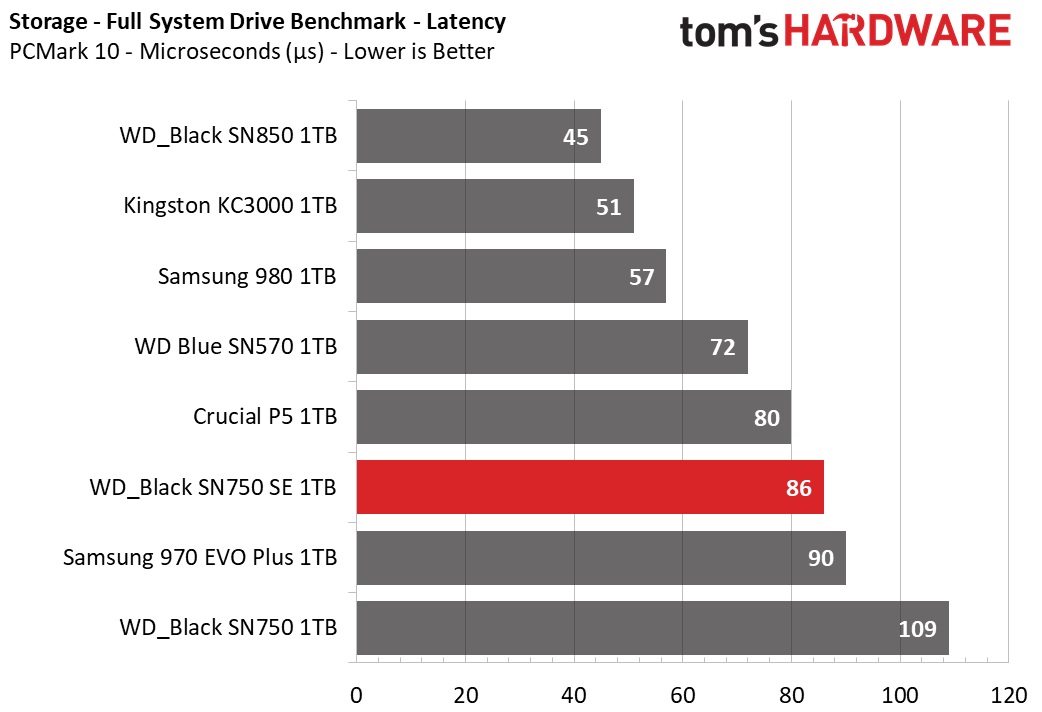
When hammered by PCMark 10’s Full System Drive Benchmark, the SN750 SE delivered average application results for a PCIe 3.0 SSD, but nothing near the performance of the fastest PCIe 4.0 SSDs on the market. It landed smack dab between the Samsung 970 EVO Plus and Crucial P5. Not only did the Crucial P5 outperform the SN750 SE here, so did the Samsung 980 and cheaper WD Blue SN570.
Transfer Rates – DiskBench
We use the DiskBench storage benchmarking tool to test file transfer performance with a custom, 50GB dataset. We copy 31,227 files of various types, such as pictures, PDFs, and videos to a new folder and then follow-up with a reading test of a newly-written 6.5GB zip file.

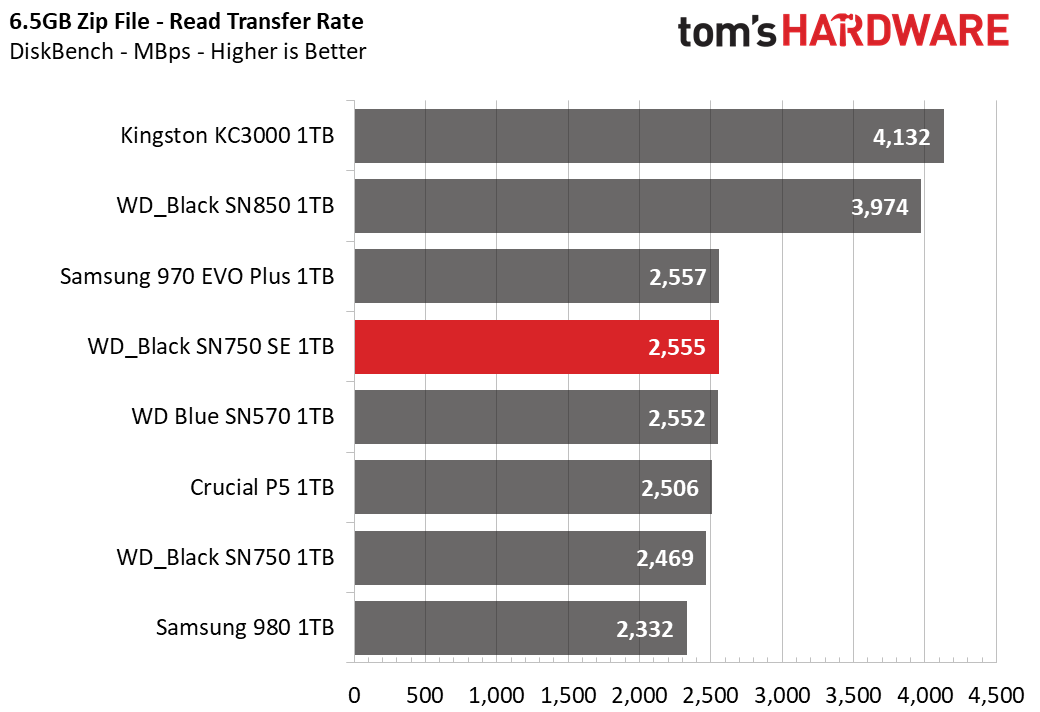
Both the WD Black SN850 and KC3000 deliver stellar transfer performance, but once again, the WD Black SN750 SE delivered weak performance closer to an average PCIe 3.0 SSD than a leading-edge PCIe 4.0 equipped model.
Get Tom's Hardware's best news and in-depth reviews, straight to your inbox.
Synthetic Testing - ATTO / CrystalDiskMark
ATTO and CrystalDiskMark (CDM) are free and easy-to-use storage benchmarking tools that SSD vendors commonly use to assign performance specifications to their products. Both of these tools give us insight into how each device handles different file sizes.
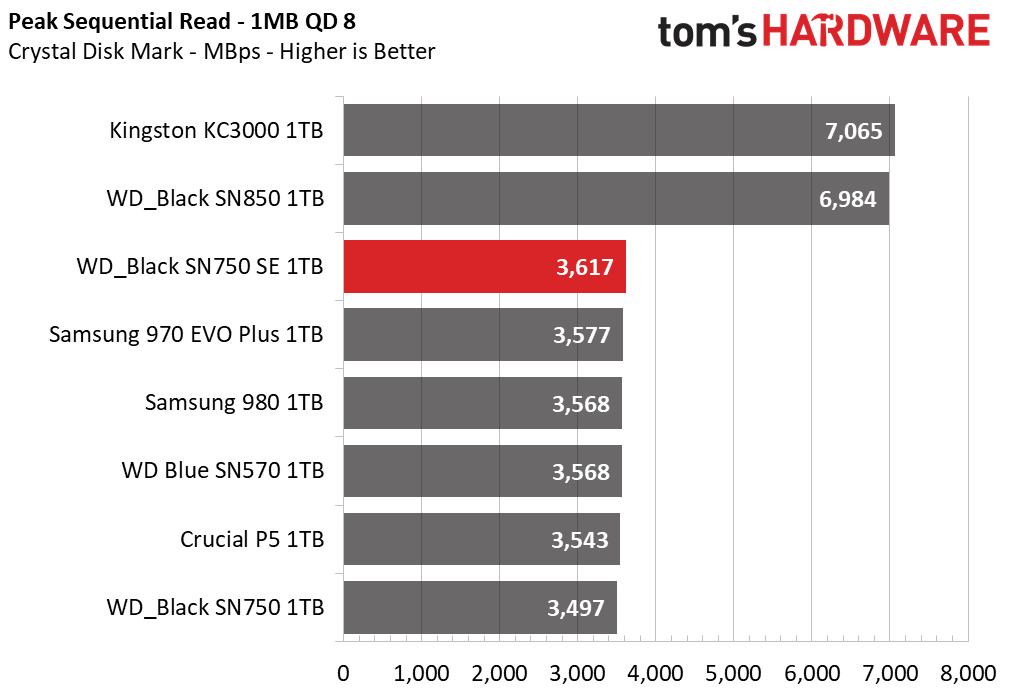




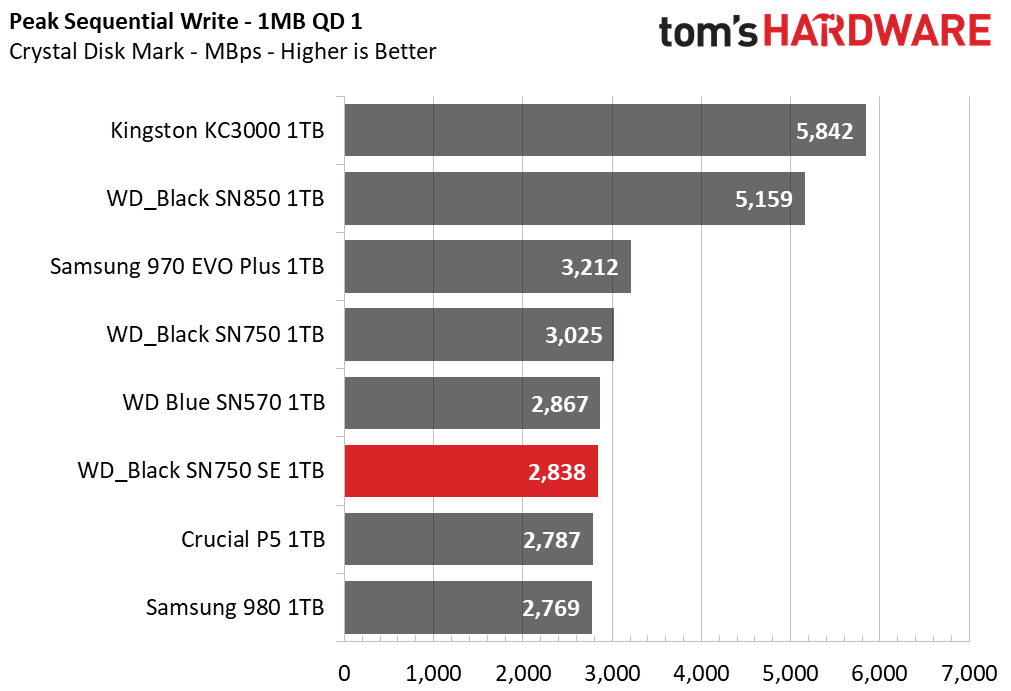
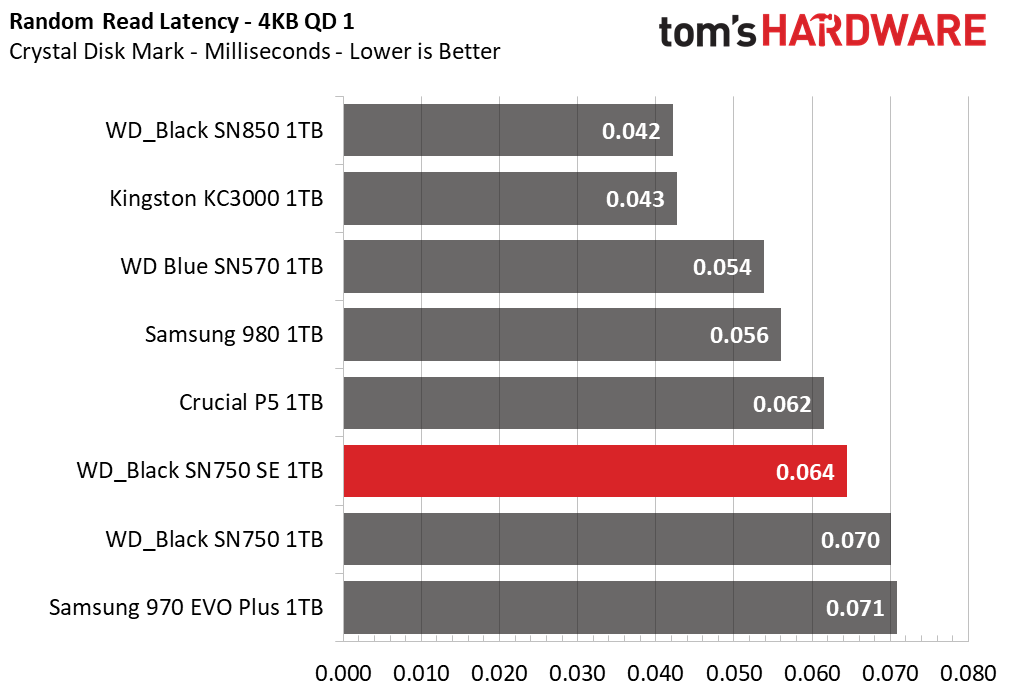







In Atto, the WD Black SN750 SE’s sequential performance scaled well beyond the standard WD Black SN750, but Crystal Disk Mark revealed weaker performance at a QD of one (QD1). Furthermore, the SN750 SE’s random read and write latency beat out the SN750 at lower QDs, as well as during heavier loads.
Sustained Write Performance and Cache Recovery
Official write specifications are only part of the performance picture. Most SSDs implement a write cache, which is a fast area of (usually) pseudo-SLC programmed flash that absorbs incoming data. Sustained write speeds can suffer tremendously once the workload spills outside of the cache and into the "native" TLC or QLC flash. We use Iometer to hammer the SSD with sequential writes for 15 minutes to measure both the size of the write cache and performance after the cache is saturated. We also monitor cache recovery via multiple idle rounds.




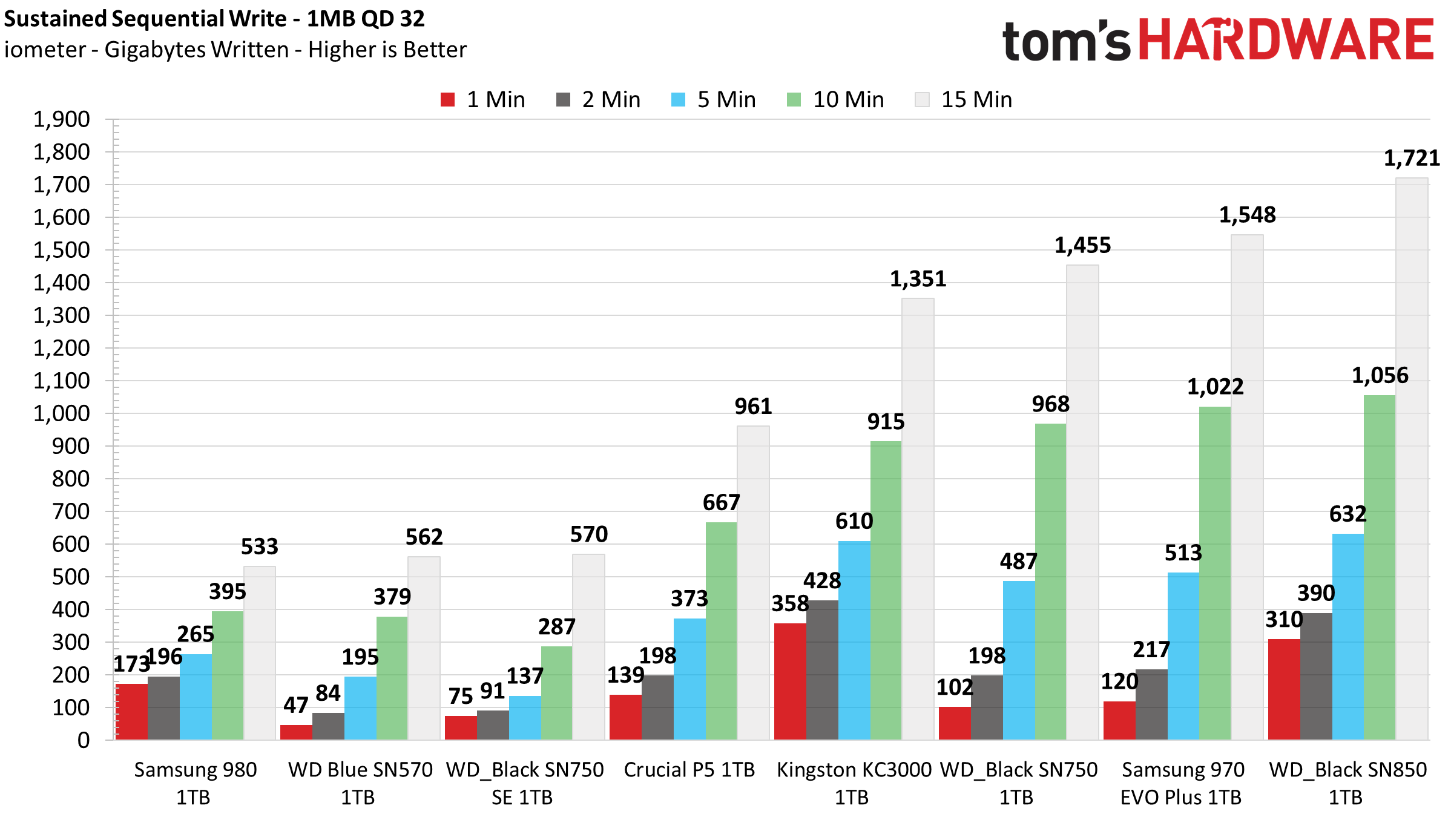
We noticed some peculiar behavior during sustained write testing that we believe is caused by the SN750 SE's DRAM-less architecture. After absorbing roughly 70GB of data at 2.9 GBps, write speed plummeted to a very inconsistent average of 250 MBps, with lows landing below 100 MBps. After writing roughly an additional 120GB of data while the cache was folding, write speeds shot up to a consistent 990 MBps for the remainder of the test.
This behavior was so strange that we retested, but the second series of tests revealed the same behavior. We then performed simple drag n' drop operations within Windows to double-check. Sure enough, performance didn't degrade as badly after the cache was exhausted, but this time the cache measured roughly 150GB before write speeds degraded to roughly 900 MBps. It wasn't until we had written roughly 750GB of data that the SN750 SE's performance degraded again. Still, when it did, speeds fluctuated very inconsistently from 60-500 MBps until the transfer was complete.
When left idle, our sample did not recover its SLC cache within our half-hour idle window. Instead, it simply wrote at direct-to-TLC speeds of 990 MBps continuously.
Power Consumption and Temperature
We use the Quarch HD Programmable Power Module to gain a deeper understanding of power characteristics. Idle power consumption is an important aspect to consider, especially if you're looking for a laptop upgrade as even the best Ultrabooks can have mediocre storage.
Some SSDs can consume watts of power at idle while better-suited ones sip just milliwatts. Average workload power consumption and max consumption are two other aspects of power consumption, but performance-per-watt is more important. A drive might consume more power during any given workload, but accomplishing a task faster allows the drive to drop into an idle state more quickly, ultimately saving energy.
We also monitor the drive’s temperature via the S.M.A.R.T. data and an IR thermometer to see when (or if) thermal throttling kicks in and how it impacts performance. Remember that results will vary based on the workload and ambient air temperature.


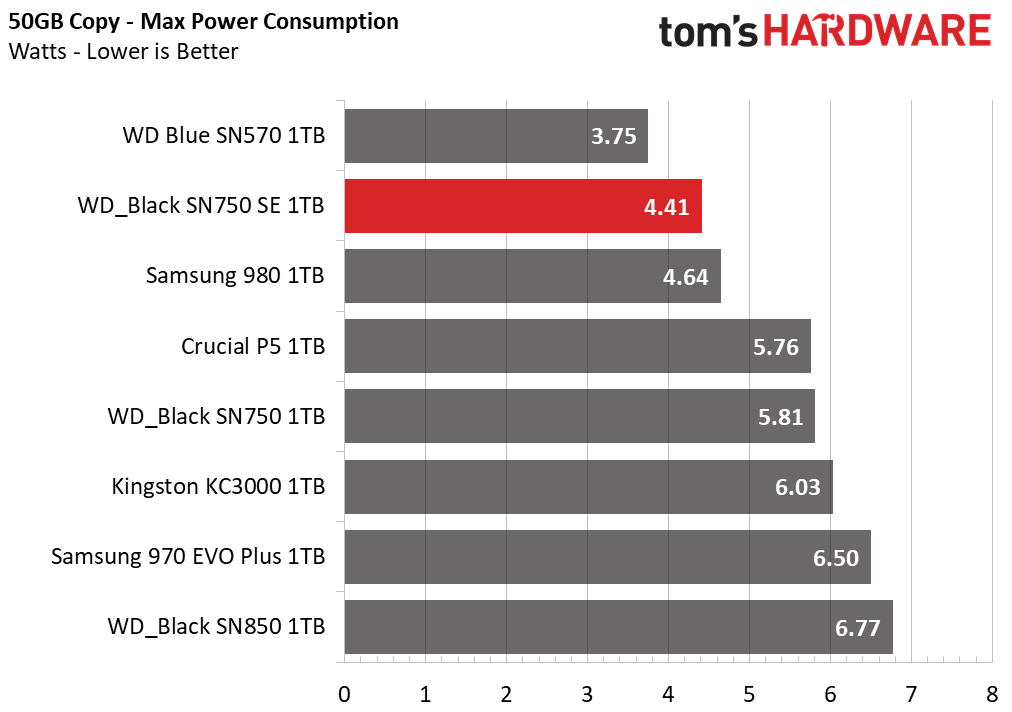

The WD Black SN750 SE ranks well in our power testing, but it could use some improvement as it landed in fourth place behind the Samsung 980. Based on the other power draw metrics, the DRAM-less SN750 SE showed lower power consumption than the SN750 across the board. This leads to low heat output at idle and during most workloads. After absorbing roughly half of its capacity from our C: drive, the SN750 SE reported peak temperatures of roughly 70 degrees Celsius in our 23-degree lab, well below its 84-degree Celcius throttling point.
Test Bench and Testing Notes
| CPU | Intel Core i9-11900K |
| Motherboard | ASRock Z590 Taichi |
| Memory | 2x8GB Kingston HyperX Predator DDR4 5333 |
| Graphics | Intel UHD Graphics 750 |
| CPU Cooling | Alphacool Eissturm Hurricane Copper 45 3x140mm |
| Case | Streacom BC1 Open Benchtable |
| Power Supply | Corsair SF750 Platinum |
| OS Storage | WD_Black SN850 2TB |
| Operating System | Windows 10 Pro 64-bit 20H2 |
We use a Rocket Lake platform with most background applications such as indexing, windows updates, and anti-virus disabled in the OS to reduce run-to-run variability. Each SSD is prefilled to 50% capacity and tested as a secondary device. Unless noted, we use active cooling for all SSDs.
Conclusion
At first glance, we weren't too fond of the WD Black SN750 SE. Traditionally, DRAM-less SSDs have been less reliable and much slower than their DRAM-equipped counterparts, especially in applications with sustained write workloads. Plus, the WD Black SN750 SE delivers just slightly faster than PCIe 3.0 sequential performance over its PCIe 4.0 interface, which is hardly exciting now that we're used to SSDs with performance exceeding 7 GBps read/write.
With its larger dynamic SLC cache and its DRAM-less design, the SN750 SE's write speed can become inconsistent in some circumstances, but WD and Phison seem to have done a very good job at tuning it for real-world use. Even without onboard DRAM, the WD Black SN750 SE managed to pull off solid mainstream performance results. The Black SN750 SE is not only better than its predecessor in many application tests, but it also runs cooler and more efficiently, making it a decent pick for laptop use.
However, lacking the newer and faster BiCS5 112-Layer TLC used in the WD Blue SN570, the WD Black SN750 SE leaves some performance on the table. The WD Black SN750 SE is an entry-level PCIe 4.0 SSD that just barely makes the grade on a technicality, lagging its high-end competition severely.
It has tough competition against the Samsung 980, which took the lead in many of our tests, proving faster and more efficient in most areas. Mind you, that is while being shackled with a PCIe 3.0 connection, too. Overall, the SN750 SE is average compared to the best PCIe 3.0 SSDs on the market, but it is more competitive on the pricing front.
Like the Blue SN570, the SN750 SE is priced to sell. Often listed at roughly $100-$110, our 1TB sample undercuts most of its competitors, both PCIe 3.0 and PCIe 4.0 alike. Built with a focus on the needs of gaming applications and value in mind, the WD Black SN750 SE proved itself a decent DRAM-less M.2 NVMe SSD that won't break the bank, making it a solid match for those on a tighter budget.
MORE: Best SSDs
MORE: How We Test HDDs And SSDs
MORE: All SSD Content

Sean is a Contributing Editor at Tom’s Hardware US, covering storage hardware.
-
zipspyder If that is a bottom end PCIE 4 SSD for storage I'll take that all day long as my main/gaming drive. Getting kind of picky now aren't we. ;)Reply